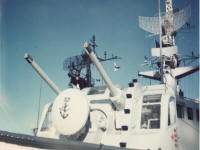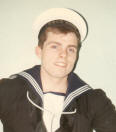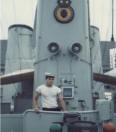|

|
|
Tracking
Radar on 3 inch Gun I Maintained |
|

|
|
OSFC Hutton |
As an Electronics Technician
In October 1968, I joined the Navy as a Firecontrol Technician.
Unlike what the name may imply this trade had nothing to do with
firefighting but rather was about controlling the fire of the guns.
The ship used system involving an x-band tracking radar to track the
aircraft and an analog computer to calculate the correct lead angle
to hit the aircraft. The computer used a number of inputs including
wind speed, air density and range as well as the relative speed of
the aircraft and ship. My job was to maintain this vacuum tube
equipment as part of a maintenance team.
In addition to working as a technician I took my turn doing a number
of general tasks. All members of the ship's company stood watches
(rotational duties) when at sea. These watches involved a
number of position that we rotated through such as steering the
ship, acting as lookouts at the top of the ship and acting as a
Lifebuoy Sentry at the back of the ship (Quarter Deck) where we
watched out for anyone falling over board. This was a very important
position, especially during rough weather. A week before
joining my first ship, HMCS Assiniboine, a young Weapons Surface
Able Seaman went up on the deck during rough weather to clear his
head from sea-sickness. He was washed overboard when a wave hit the
ship and washed him under the torpedo tubes and into the ocean.
Although the Lifebuoy Sentry sounded the alarm and the ship turned
around to search for him, he was never found. Interesting
though, I was assigned his bunk when I joined the ship a week later
and watch as the Coxswain cut the lock off his locker and cleaned it
out.

|
|
HMCS
Assissiboine |
I was also part of the focs'le party for entering and leaving
harbour. This involved standing on the focs'le (the pointed end of
the ship) when entering and leaving harbour and preparing the ships
lines to tie up the ship when it was alongside.
I also worked in
this area when the ship was refueling and replenishing at sea. The
ship was often re-supplied when we were at sea, from a large supply
ship and tanker. This required the ship to steam very close to the
tanker and required a very experienced person on the helm. The helm,
or ships steering wheel, was located 3 decks down from the bridge.
So, the officer commanding the ship gave the helmsman instructions
on the course to steer with an intercom system. Given the inherit
delay in this method it was very difficult to keep the ship on
course while it was only 25 yards from the supply ship.
|